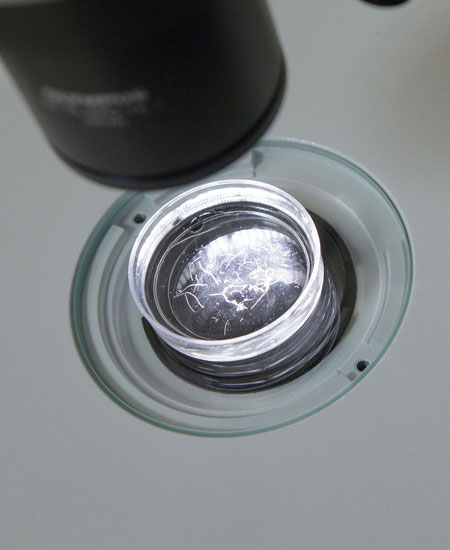One-World Research
Friday, January 27, 2017
Experts tackling viruses that hit humans and animals

Research is a key component of our mission at Oklahoma State University’s Center for Veterinary Health Sciences. Current collaborative efforts focus on herpes viruses that affect primates, humans and horses.
“I have been very lucky to work with Dr. Eberle and his technician, Darla Black, since coming to Oklahoma State University in 2003,” Maxwell says. “Dr. Eberle is one of the world’s premier researchers in Monkey B virus and in Herpesvirus Papio 2 (HVP-2). HVP-2 affects baboons and Monkey B virus affects macaques.”
While neither virus produces much disease in their host species, they can produce devastating neurological disease and death in the majority of people they infect.
“B virus is very closely related to herpes simplex virus (HSV) that people have,” Eberle says. “In monkeys, it’s just like HSV in humans; they get oral and genital lesions. But when (Monkey B virus) is transmitted to humans, it’s about 80 percent lethal. Because Monkey B virus is so dangerous, it is the primary zoonotic concern for people working with macaques, which are a really essential animal model for biomedical research like AIDS research.”

“So we are interested in preventing these devastating consequences of infection in people by figuring out which antiviral drugs will best protect people from developing disease if they are exposed to Monkey B virus or HVP-2,” Maxwell says. “Although HVP-2 has not been shown to be pathogenic to people, it is being used as a model for Monkey B virus because Monkey B virus is so dangerous to work with. Our research has shown that HVP-2 does parallel Monkey B virus in its drug sensitivity.
“We are exploring the use of different antiviral drugs in mice, either administering them systemically, throughout the whole body, or topically to the site of infection because, of course, we can’t actually study this in people,” she adds. “People are very rarely bitten by macaques and so are rarely affected by this disease. However, the disease has been documented and when it occurs, the effects are so devastating that we would really like to be able to offer better protection for these people.”
The major documented cause of zoonotic B virus transmission is via monkey bites or scratches to animal care personnel. However, other inadvertent modes of infection including needle stick injuries could occur in research personnel.
“The one thing that I want people to know is that when I was a veterinary student, I was told that if you were ever infected with Monkey B virus from an animal that you are working with in a zoo or in some type of primate research colony, that you were basically dead. There is no cure for it and no way to prevent the infection,” Maxwell says. “Based on our research in mice, we think we really could prevent people from developing the severe systemic illness and neurological disease that occurs with Monkey B virus infection. We think that prophylaxis is possible and doable and could be more effective than current CDC guidelines, which would be very important for those who are potentially exposed to Monkey B virus.”

The team’s research has shown that administering drugs such as ganciclovir and cidofovir early in the course of the disease can protect mice. Some preliminary evidence suggests that these drugs can be very effective when administered topically on a bite wound, which would be much less invasive for the patient.
“Cidofovir, which hasn’t previously been used to treat Monkey B virus, seems to be much more effective than ganciclovir,” Eberle says. “You can use it at a much lower concentration. But still, once the virus is in the nervous system, cidofovir doesn’t work.”
“Our idea is that ultimately in any place where monkeys are housed, a treatment pack would be available,” Maxwell says. “Anyone who is scratched or bitten could immediately apply this topical antiviral to the skin. This would prevent the infection from ever getting established. If the infection does become established, systemic antiviral drugs are still recommended but at that point, they are far less successful. Even if people survive the infection, they are likely to have lasting neurological damage.”
Eberle, Maxwell and Melanie Breshears, DVM, Ph.D. and an American College of Veterinary Pathologists (DACVP) diplomate, recently received a National Institutes of Health grant that will allow the team to work full time on this project.
“We’ll finish the trials with cidofovir,” Eberle says. “There are a lot of different macaque species. They all have their own version of B virus. So will cidofovir or ganciclovir protect against all these different variants of B virus? Will it protect against extremely high doses of virus? How long after infection can you wait before starting the drug? We’ll want to look at combinations of drugs as well as other experimental drugs to see if maybe that will help with infections once the virus is in the nervous system.”
“It’s a very rare illness and thus, understudied,” Maxwell adds. “Those people who are impacted are often those who are trying to help human health in other ways, such as in primate research or people who are trying to maintain the animals at zoos. I think those people deserve the highest level of protection that we can provide.”
Maxwell is also involved with a multidisciplinary team that is studying the mitigation and prevention of equine herpesvirus myeloencephalopathy in horses.
“It’s a disease that’s become increasingly important to the equine industry due to outbreaks that result in quarantines, closures of race tracks and horse shows, as well as individual horses that are affected,” she says. “Since the disease can be so devastating, it can result either in death or in damage to the career of a show horse or race horse.”
“The principal herpesvirus of concern is Equine Herpesvirus type 1 or EHV-1,” Rezabek says. “This is an endemic virus in the United States. It affects all kinds of horses in all regions. It’s been present a long time. The majority of the horses infected with EHV-1 develop an acute respiratory disease. A moderate number also suffer abortions. A small subset, however, develop a neurologic disease that’s typified by hind limb ataxia, urinary incontinence and some other neurologic signs.
“Certainly the disease has been around for a long time,” he continues. “However, more recently in 2003, there was an outbreak in Ohio that had a high infection rate. That was followed by an outbreak in some show horses in Florida in the winter of 2006 where a large number of horses developed neurologic signs when acutely infected with herpes virus.”
There have been other western horse show outbreaks of this disease culminating in an outbreak in Ogden, Utah, in May 2011.
“It was a cutting show,” Rezabek says. “There were 421 primary horses that were exposed at that Ogden show and subsequent to that when they all went home, there were 1,685 secondary and tertiary exposed horses. The economic impact of that disease outbreak was significant on the industry because a lot of shows had to be canceled.”
These disease outbreaks have continued intermittently at racetracks, horse shows and training centers throughout the nation; the most recent outbreak was in Sunland Park, a racetrack in New Mexico.
“That outbreak started in January 2016 and was declared clear March 9,” Rezabek says. “There were 79 infected horses and six fatalities. The economic impact of that Sunland Park outbreak on racing in the state of New Mexico was estimated at $1.8 million.”
The team, led by Maxwell and including Eberle; Rezabek; Lyndi Gilliam, DVM, Ph.D., American College of Veterinary Internal Medicine (DACVIM) diplomate; Todd Holbrook, DVM, DACVIM, American College of Veterinary Sports Medicine and Rehabilitation diplomate; Dianne McFarlane, DVM, Ph.D., DACVIM; and Tim Snider, DVM, DACVP, Ph.D., is interested in preventing the disease either through vaccination or through the use of antiviral drugs.
“We’ve done a pilot study where vaccination appeared to be protective and presented on that,” Maxwell says. “Some of the drugs we’ve investigated have been valacyclovir and ganciclovir. What we found with those drugs is that if we are able to administer the drugs very early in the course of disease, either before or immediately after infection, then we are able to prevent the disease with the oral drug valacyclovir. This is a more convenient drug that veterinarians can issue a prescription for and owners are able to get it from a pharmacy. If treatment didn’t occur until late in the course of the disease, then ganciclovir worked better.
“So we have reason to think that both vaccination and the use of antiviral drugs can be protective for horses,” she concludes. “We think this approach can be helpful for the industry either in protecting individual horses at the time of outbreaks or in providing additional protection in horses that are already showing signs of equine herpesvirus myeloencephalopathy. An outcome that has already been realized due to this research is increasing use of valacyclovir in horses with exposure to EHV-1 during an outbreak. All of these measures together, we think, can mitigate the disease and prevent as many horses as possible from developing the most destructive effects of this virus.”
For more information on research being conducted at OSU’s Center for Veterinary Health Sciences, visit cvhs.okstate.edu/Research.
To watch a video on OSU’s research, visit okla.st/2fNmSAc.
Three of the main researchers involved include RICHARD EBERLE, Ph.D., molecular biology/virology professor in the Department of Veterinary Pathobiology; LARA MAXWELL, DVM, Ph.D., American College of Veterinary Clinical Pharmacology diplomate and professor in the Department of Physiological Sciences; and GRANT REZABEK, MPH, DVM, assistant clinical professor in the Department of Veterinary Pathobiology and veterinary pathologist at the Oklahoma Animal Disease Diagnostic Laboratory.
Drs. Richard Eberle (from left), Lara Maxwell and Grant Rezabek are collaborating on research on herpes viruses.
“The one thing that iI want people to know is that when I was a veterinary student, I was told that if you were ever infected with monkey b virus from an animal that you are working with in a zoo or in some type of primate research colony, that you were basically dead. There is no cure for it and no way to prevent the infection.” — Dr. Lara Maxwell
Gary Lawson / University Marketing
